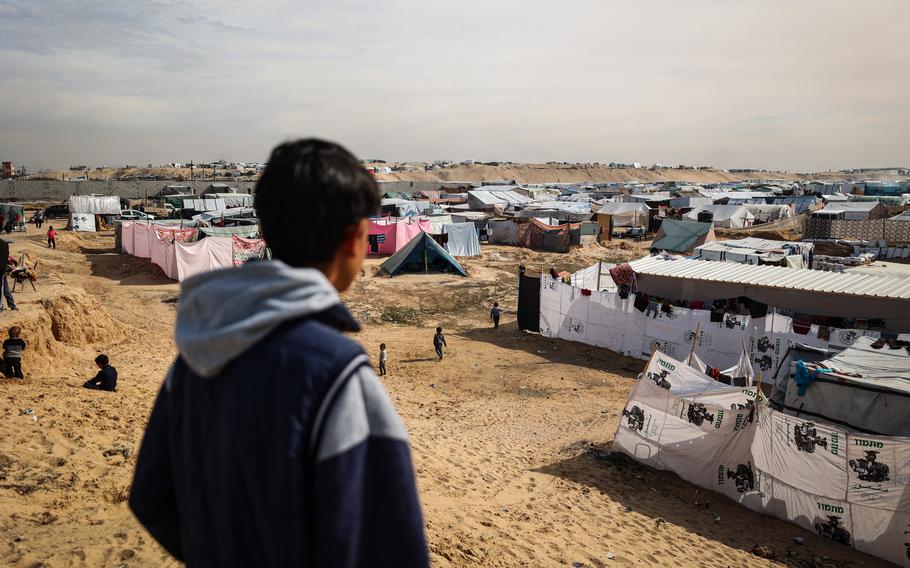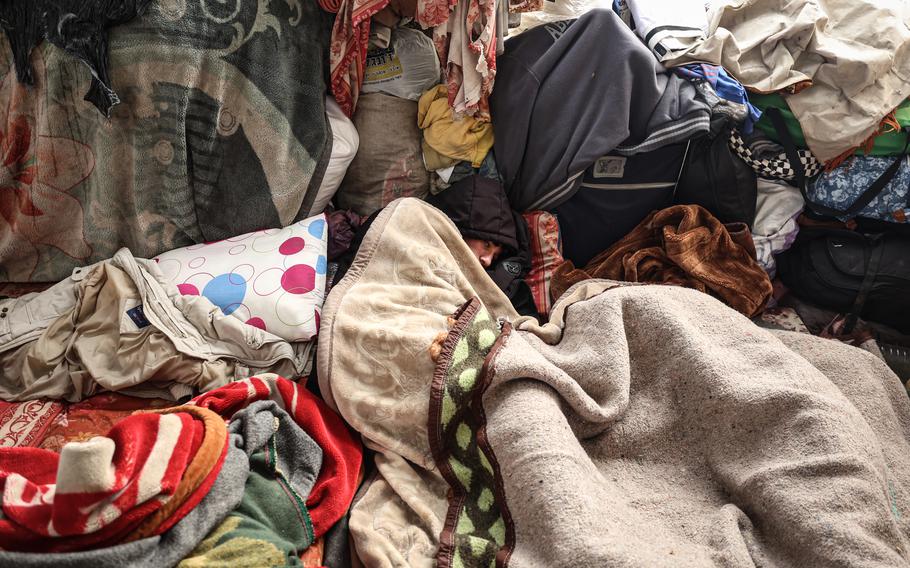
A man looks over a camp that houses thousands of displaced people south of Rafah on Jan. 21, 2024. (Loay Ayyoub for The Washington Post)
Israeli authorities said they are expanding their military operation to oust Hamas from Gaza to one of the last remaining refuges in all of the strip: Rafah, a city on the border with Egypt.
“We complete the mission and will continue to Rafah,” Defense Minister Yoav Gallant wrote on social media on Thursday, describing how Israeli forces had “dismantled” the militant brigade in the city of Khan Younis, a larger city less than seven miles north.
Aid workers and humanitarian organizations warned that Rafah is already dangerously crowded with civilians who have been displaced at least once, many of whom are sick or on the verge of famine. Further conflict in the area runs the risk of causing significant harm, they said.
“The loss of life we face if Israel goes down into Gaza is huge,” said Bob Kitchen, vice president for emergencies at the International Rescue Committee, a humanitarian relief organization operating in Gaza.
Almost nine out of ten Palestinians in Gaza have been displaced
The population of Rafah has swelled to “at least” 1.4 million people, Juliette Touma, director of communications for the U.N. agency for Palestinian affairs, UNRWA, wrote in a message. “This is five times the population pre-war,” Touma said of Rafah, whose population was estimated at 280,000 before Oct. 7.
Israeli officials have not specified what its plans for Rafah look like. The country’s military has already conducted strikes in the area, including an airstrike that hit near the Kuwaiti Hospital in the city in December that killed at least 18 people, according to hospital staff.
The war in Gaza has drastically reshaped the demographics of the strip. Almost nine out of ten people living in Gaza are now displaced, according to U.N. estimates, while the World Health Organization Director General Tedros Adhanom Ghebreyesus said on Wednesday that “over 100,000 Gazans are either dead, injured or missing and presumed dead.”
Before Oct. 7, the most populated portion of the strip was Gaza City in the north.
- On Oct. 13, six days after the Hamas-led assault on Israel that began the war, Israel ordered the evacuation of more than 1 million people living in the areas above the Wadi Gaza wetlands. Many took refuge in Gaza’s second-largest city, Khan Younis, in the south.
- At the start of December, Israeli authorities ordered Palestinians in Khan Younis to move to new areas as it conducted military operations in the city.
- More than half of Gaza’s total population is thought to now be in Rafah, where many were “living in makeshift structures, tents, or out in the open, ” Jens Laerke, a spokesman for the U.N. Office for the Coordination of Humanitarian Affairs (OCHA), said on Friday, adding that the city had become a “pressure cooker of despair.”

Displaced Palestinians in Rafah take shelter from rainfall and cold weather on Feb. 2, 2024. (Loay Ayyoub for The Washington Post)
A mounting humanitarian crisis in Rafah
While Rafah lies on the border with Egypt, humanitarian groups have warned that the amount of aid crossing the border is nowhere near enough to meet the needs of an increasingly desperate population.
“People in Gaza risk dying of hunger just miles from trucks filled with food,” Cindy McCain, head of the World Food Program, said in an appeal for new action to allow more trucks to enter Gaza.
One Palestinian aid worker, who spoke on the condition of anonymity as he was not authorized to speak publicly, wrote in a message that the widespread use of tents reminded him of stories his grandfather told him about the living conditions for refugees after the 1948 Israeli-Arab war. The tents, which can be up to 200 square feet in size, would house an entire family or two, the aid worker said.
Winter temperatures have added to the misery. “With this cold and rainy weather, the tent is the last place anyone would want to be in!” they wrote.
Sanitary precautions have broken down amid the overcrowding. “Thousands and thousands of people are sharing individual toilets,” Kitchen said, adding that IRC workers in Rafah had seen “queues of 4 to 5 hours” to use the bathrooms. Open defecation and urination create public health risks.
“We’re already seeing massive reports of acute watery diarrhea, which I think, if tested, would be proven to be cholera,” Kitchen said.
The humanitarian crisis is compounded by a political one, as at least ten Western governments this week suspended funding to UNRWA, the chief logistical force for aid in Gaza. The decision to halt funding came after Israel shared a dossier that alleged more than a dozen UNRWA employees had been involved in the Oct. 7 attacks on Israel and alleged widespread support for Hamas and other militant groups within the organization.